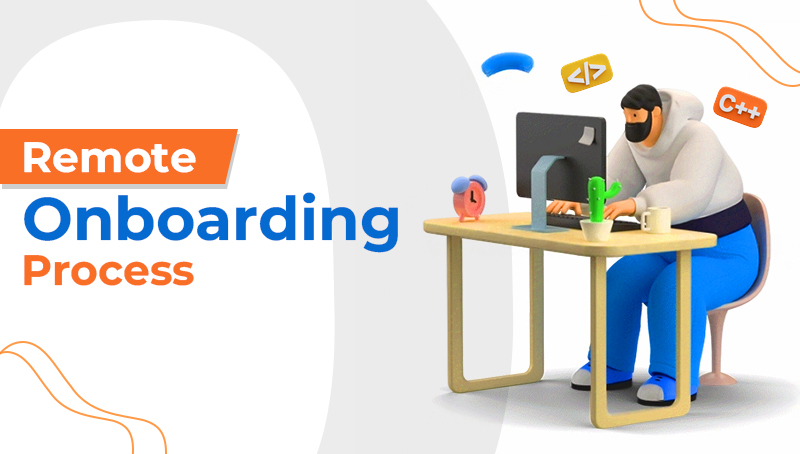Remote work has become the new standard, and businesses are eager to embrace it. As a result, the onboarding process for new developers has experienced a shift of its own. The days of in-person orientations and office visits are over; instead, enterprises must traverse the complicated landscape of remote onboarding to ensure their new talent integrates seamlessly into their virtual teams.
This blog is your entire guide to How to Onboard New Developers Remotely. We recognize that receiving and integrating new team members from afar provides unique difficulties and possibilities. Whether you are considering In-House vs. Remote Development: Which to Choose, we will lead you through every stage of the remote onboarding experience, from defining clear objectives to encouraging team cooperation and guaranteeing technical competency.
This blog will provide you with practical tactics, best practices, and important insights to help you not only bridge the geographical divide but also build a strong, cohesive team while encouraging the growth of your newly onboarded developers.
Importance of Remote Onboarding
As remote work grows more common, remote onboarding has become a vital procedure for firms. Several crucial elements will help you understand the relevance of remote onboarding:
- Global Talent Pool: Remote onboarding helps firms tap into a worldwide talent pool, providing them access to a broader choice of competent engineers.
- Cost-effectiveness: It removes the requirement for real office space as well as the expenditures associated with in-person onboarding.
- Employee Flexibility: Remote onboarding promotes a more flexible work environment, which appeals to many developers, particularly those who like working from home.
- Business Continuity: Remote onboarding supports company continuity and minimizes disruptions during times of crisis, like as the COVID-19 epidemic.
Benefits of Remote Onboarding
- Flexibility: New developers may join the team from anywhere in the world, allowing them to work in an environment that is most comfortable and productive for them.
- Cost Savings: Organizations may save money on office space, travel, and other in-person onboarding expenditures.
- Diversity and Inclusion: By removing geographical obstacles and making it simpler for people from all backgrounds to join your team, remote onboarding encourages diversity and inclusion.
- Scalability: Because remote onboarding methods can be standardized and readily repeated, scaling your workforce becomes more manageable.
Process of Evaluating and Hiring Remote Developers
- Hiring Process:
- Define Requirements: Clearly explain the role’s skills, experience, and expectations.
- Application analysis: To shortlist candidates, carefully analyze resumes, portfolios, and cover letters.
- Interviews: Use video calls to conduct interviews to assess technical abilities, soft skills, and cultural fit.
- Skills Testing: To assess technical skills, and administer coding exams or assignments.
- Reference Checks: Contact references to confirm a candidate’s background and employment history.
- Evaluating Tasks:
- Technical expertise: Evaluate their technical expertise in areas such as programming languages, frameworks, and tools relevant to your project.
- Communication Skills: For remote cooperation, strong written and vocal communication skills are required.
- Self-motivation: Remote developers must be self-disciplined and capable of efficiently managing their workload.
- Adaptability: Assess their adaptability to diverse time zones, cultures, and work situations.
Step-by-Step Guide for Preparing for Remote Onboarding:
- Examine Your Onboarding Process:
- Current Procedure: Examine your present onboarding procedure. What characteristics of remote work may be modified?
- Documents: Make sure all onboarding documents and resources are digitally accessible.
- Feedback: Gather input from current team members who have gone through remote onboarding. What was successful, and what might be improved?
- Obtaining Required Tools and Resources:
- Communication solutions: Invest in dependable video conferencing, messaging, and collaboration solutions to improve team communication.
- Project Management Software: Implement project management tools to monitor tasks and projects, which will help new developers stay organized.
- Access to Documentation: Ensure that all essential documentation, knowledge bases, and training materials are available to new developers.
- Design a timeline:
- First Day: The first day should be devoted to introductions, culture, and high-level information about the business.
- First Week: Start technical instruction and offer an overview of current projects.
- First Month: The first month is spent honing technical skills and progressively integrating new developers into project teams.
- Meeting of Welcome and Orientation:
- Introductions: Allow team members to introduce themselves and explain their duties.
- Company Culture: Discuss the culture, values, and mission of the organization.
- Key Contacts: Introduce essential connections for different elements of the task.
- Technical Training:
- Online Courses and Tutorials: Provide access to online courses, tutorials, and learning platforms relevant to their work.
- Mentorship: Assign a mentor or veteran developer to guide the new recruit, answer questions, and give support.
- Access to Documentation:
- Knowledge Bases: Keep knowledge bases and documentation up to date so that new developers may refer to them.
- Self-Learning: Encourage self-learning by making materials available for individual problem-solving.
- Virtual Team Building Activities:
- Icebreakers: To establish a welcoming atmosphere, begin meetings with icebreakers or team-building exercises.
- Virtual Socials: Organize virtual social gatherings to encourage casual conversations.
- Feedback and Evaluation:
- Surveys or feedback forms: Use surveys or feedback forms to get feedback on the effectiveness of remote onboarding.
- One-on-One sessions: Hold one-on-one sessions to go over the onboarding process in greater depth.
- Making Necessary Adjustments:
- Continuous Improvement: Be fluid and responsive, looking for ways to improve the onboarding experience on a regular basis.
- Address Any Pain Points: Address any pain points or issues that new developers have discovered.
- Continuous Improvement:
- Keep Up to Date: Keep up to date on industry trends and new solutions to improve the remote onboarding experience.
- Iterate and innovate: Keep iterating and inventing your remote onboarding process to match your organization’s changing demands.
Where to Find Remote Solutions?
Finding remote developers entails investigating numerous platforms and strategies for connecting with talent all around the world. Best Sites to Hire Offshore Developers: Here’s a quick rundown of places to discover remote developers:
- Platforms for Freelance Work: Websites such as Digitalogy, Upwork, Freelancer, and Toptal link businesses with freelancers all over the world. You may submit your project specifications and hire developers based on their bids.
- Job Boards: Sites such as We Work Remotely, Stack Overflow Jobs, and Remote.co specialize in remote job postings, making it simpler to discover developers who prefer remote work.
- Developer forums: Online forums such as GitHub, Stack Overflow, and Reddit’s r/forhire are frequent gathering spots for developers looking for remote work. Participating in forums and sharing job advertisements might be beneficial.
- Social Media: Social media platforms such as LinkedIn, Twitter, and Facebook allow you to network as well as advertise job vacancies. To connect with remote devs, join relevant groups and follow industry-specific hashtags.
- Recruitment Agencies: Specialized employment firms may connect you with remote developers who fulfil your unique requirements. They frequently have existing networks and can help to speed up the recruiting process.
- Websites for Remote Work: Websites such as Remote OK, FlexJobs, and Remote.co collect remote job ads from numerous industries, including software development, making it simpler to find remote talent.
Conclusion
Finally, remote onboarding is a purposeful approach to talent acquisition and retention, not merely a reaction to present conditions. It facilitates access to a broad and capable global workforce while lowering costs and boosting flexibility.
You can design a strong remote onboarding process that ensures new developers integrate successfully into your team, fit with your corporate culture, and become valuable contributors to your organization’s success by following the steps indicated in this comprehensive guide.
Keep in mind that remote onboarding is a dynamic process that requires ongoing development and modification. Accept the chances it provides, and you’ll not only excel in remote onboarding but also flourish in the ever-changing remote work world.
FAQs
Ans. To make new developers feel like they are a part of the team in a remote setting, establish frequent contact, promote cooperation, build a friendly environment, and give chances for social engagement.
Ans. For effective learning and development, best practices for remote training include clear objectives, interesting content, interactive sessions, regular feedback, accessible resources, and adapting to the distant environment.
Ans. Use project management tools to follow the progress of remote engineers, define clear targets and milestones, organize frequent check-ins, and track their work using transparent communication and collaboration platforms.
Ans. Include introductions to the team, an overview of the corporate culture, important contacts, and a summary of the onboarding process in the welcome session for new developers.
Ans. Use clear channels (such as video meetings and chat) to improve remote team communication, create frequent check-ins, encourage active involvement, and promote openness in providing information and updates.







